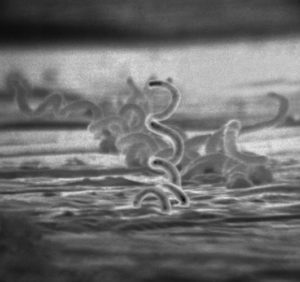Soft on STDs
 Electron micrograph of of the bacterium that causes syphilis.
Electron micrograph of of the bacterium that causes syphilis. A recent report from the Center for Disease Control (CDC) indicates that this country saw a record number of cases of sexually transmitted disease (STDs) in 2016: more than two million new cases of gonorrhea, syphilis, and chlamydia. It’s almost like we don’t let schools teach our kids about the proper use of contraceptives.
In fact, a need for better sex education is one of the issues this report highlights; as I have written previously, allowing the ghosts of some of our puritanical forerunners to dictate health class curriculums is a great way to ensure that adolescents are not having safe sex. But archaic sex education laws are not the only factor contributing to stratospheric rates of STD infection.
Villains in the fight against STDs
Poor sex education: This is an issue that has been beaten to death, but apparently not hard enough as Tennessee state legislators decided that sex education should be required in public schools only if the teen pregnancy rate rises above a certain level. It’s absurd that schools require parents to get their children vaccinated for things like measles, but then aren’t allowed to teach their students about how to avoid other totally preventable diseases. It’s high time legislators accepted that the words on a box of condoms can do more to reduce STD (and teen pregnancy) rates than all of the words in the Bible.
Attacks on Planned Parenthood: I’m sure I’m not the first to point this out, but if you think abortions are evil, then investing in contraception access might be a good idea. Unfortunately, Planned Parenthood has many enemies—from one-dimensional thinkers who see the organization as an abortion drive-thru to fundamentalists who view all family planning services as blasphemous. As long as the free market continues to keep basic health services out of reach for many Americans, Planned Parenthood will continue to be vital in the fight for sexual health. Those seeking to strip it of funding or force it to shutter locations are tier one villains in this narrative.
Archaic institutions: As an undergraduate, I could get free condoms from my student health center at Davidson College, which is affiliated with the relatively progressive Presbyterian Church (USA). Many other students, however, don’t have this option—Catholic universities such as Boston College, Fordham University, and Villanova have policies that make it next to impossible to distribute or obtain contraception on campus (at Bob Jones University condom possession may be a high crime—I’ll have to look into it). Now, is it surprising that religious schools view contraception as a threat to the morals of their students? No. But is it counterproductive and harmful to the students themselves? Very. Sex, as far as I know, remains very popular among college students, and so it is imperative that they be provided with the means to practice it safely.
Funding cuts for health service providers: The three STDs that this report focused on—chlamydia, gonorrhea, and syphilis—are all treatable, but only if the patient knows that they’ve contracted one of them. Unfortunately, budget cuts have taken a serious toll on the clinics that provide testing and treatment, and it looks as though this trend will continue under the Trump administration. As we see rising support for a single-payer healthcare system, we can only hope that more policymakers will come to embrace the notion that condoms (and other prophylactics) and STD testing should be free.
A generally defective healthcare system: This last villain is perhaps the most obvious: at every stage, from prevention to diagnosis to treatment, many Americans simply cannot access the care that they need. Planned Parenthood is great, but it is a Band-Aid on the gaping wound that is this country’s healthcare system. A great (or rather, horrible) example of this is the rising number of babies born with congenital syphilis, something that would be totally preventable if adequate prenatal care were available for all women. Instead, we see children entering this world already scarred by a public health failure that shows no signs of receding.
